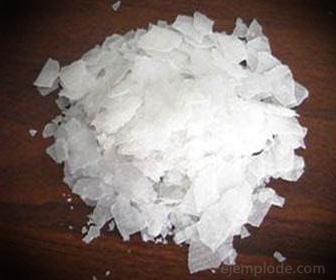Uses of Caustic Soda
Chemistry / / July 04, 2021
Caustic soda is the commercial name given to the Sodium hydroxide in solution. Sodium Hydroxide is an inorganic chemical compound, with the formula NaOH, which is characterized by acting in aqueous solution as a Strong Base. It is considered the most important of the Hydroxides. It has a useful variety of applications, including cleaning domestic and industrial stoves.
Characteristics of Caustic Soda
The Caustic Soda or Sodium Hydroxide It is one of the main compounds of Sodium. It is a white, hygroscopic solid (it absorbs water from the environment or proximity), which corrodes the skin and dissolves very well in water. It is prepared by two different methods:
1.- Treating Sodium Na Carbonate2CO3 with slaked lime Ca (OH)2
2Na+ + CO3-2 + Ca+2 + OH- -> CaCO3 + 2NaOH
Calcium Carbonate CaCO is separated by filtration3 precipitate, and the passing liquid evaporates to dryness. In the soap industry, the Sodium Hydroxide solution (the filtered liquid) is used directly without evaporating.
2.- By electrolysis of a solution of Sodium Chloride NaCl (Brine) in a special device called Nelson Cell. By passing electric current through a solution of
Chloride, Chlorine is released at the anode (positive electrode); the chloride ion, Cl-, loses an electron, oxidizing accordingly.If the electrode is made of Carbon, which does not react with Chlorine, it dissolves in water until it forms a saturated solution, and then escapes in a gaseous state. Hydrogen remains free at the cathode (negative electrode), and Sodium Hydroxide is formed.

Caustic Soda Applications
Caustic Soda or Sodium Hydroxide is used in the manufacture of paper, textiles, rayon and cellulose fibers, dyes, soap, bleaching liquids (with chlorine), and also serves to purify petroleum products, dissolve fats in stoves and neutralize currents acidic.
Examples of use of Caustic Soda
1.- In the manufacture of paper: Caustic soda NaOH is used as a chemical agent for bleaching paper fibers. Its effect is also accompanied by Sodium Hypochlorite NaClO, and paper fibers are left with a sufficient whiteness, which exceeds 88% if it is for office or stationery use.
2.- In the manufacture of textiles: Caustic soda helps in the bleaching of textile fibers, generating a whiteness such that it allows adding the colorants that will create the final product later.
3.- In soap making: Caustic Soda is added to animal fat that has been treated to create soap. This fat contains mostly Stearic Acid. The reaction of Caustic Soda with Stearic Acid is called Saponification. At the end, colorings and flavorings are added to give the soap a commercial touch.

4.- In cleaning domestic and industrial stoves and ovens: Caustic Soda, acting as a strong base, is capable of softening and removing the fats that have remained adhered to the stoves and ovens due to use. Cleaning is much more effective when combined with abrasive detergents, such as those that come in powder form. These help to scrub stuck grease and clean at the same time.
5.- In bleaching liquids that contain Chlorine: Household cleaning agents contain a small proportion of Caustic Soda, which is not as harmful or corrosive to human skin. Anyway, you have to manage it carefully when cleaning.
6.- To Neutralize Acidic Streams or Spills: Being a Strong Base, Sodium Hydroxide is the perfect substance to neutralize dangerous acid spills. It works just as well if the spill is Hydrochloric Acid or Sulfuric Acid. Only the necessary amounts of caustic soda are added.
7.- To Regulate the pH in Acidic Solutions: Sometimes you will have samples of water or aqueous solution that are too low pH for the required purpose. Dilute sodium hydroxide solution is added to regulate the pH, and make it rise. If the required change is large, a slightly more concentrated Sodium Hydroxide solution can be used.
8.- As a Chemical Reagent: Caustic Soda works as an active chemical substance, both in organic chemical reactions and inorganic chemical reactions. It is capable of attacking the alkyl halides, releasing the halogen, either Chlorine, Bromine, iodine, and leaving a Sodium halide as a residue; an alcohol is generated, in those cases.
9.- As a dehydrator: Sodium Hydroxide, due to its hygroscopic property, can be applied when it is required to retain the water of some substance. It can be used, for example, in the dehydration of wet wood or sawdust, to make it burn more easily. Only if the amount of water present is not so much.
10.- As a standard solution: Caustic Soda in the form of a Standard Solution (Solution of Known Concentration) serves to volumetric analysis. Thus, the concentrations of known components in liquid samples are discovered.

